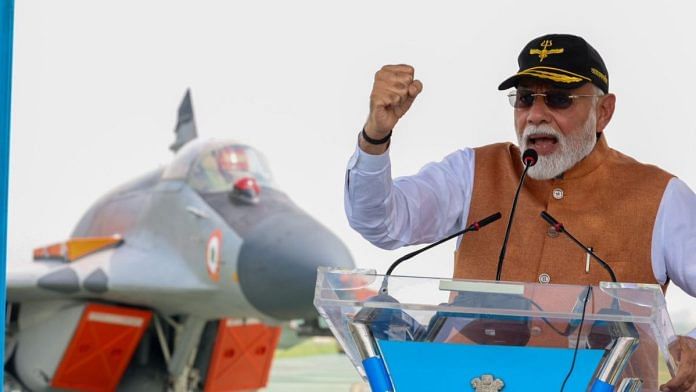So, this is what catharsis feels like. In just over three weeks, Prime Minister Narendra Modi has shifted the goalpost from business as usual to a “new normal” for India and terrorism. In doing so, he has taken the public on a roller-coaster ride of emotional responses.
Listen to his speeches since the killing of 26 civilians by terrorists in Pahalgam, Kashmir, on 22 April—two before Operation Sindoor and two shortly after hostilities stopped.
We seesawed from grief and battle cries of “war” to relief as the PM went from vowing vengeance in Madhubani on 24 April to calm, composed strength in his address to the nation on 12 May. In between, pain was the theme of his Mann ki Baat of 27 April.
During Operation Sindoor, while TV news anchors breathed fire, the PM remained silent—seen at countless meetings, but not heard.
Then, two days after the ceasefire announcement on 10 May, Modi brought “a much-needed sense of relief and closure” to the sequence of events in his address to the nation (The Indian Express). He spelt out a “new war doctrine” (India Today)—justice had been delivered for the Pahalgam attack and now there was a “new normal”, he said.
Finally, during his visit to Adampur air base on 13 May, amid cheering Air Force personnel, the PM went from a battlefield “roar” to a warning for terrorists and for Pakistan: India wants peace, but if you attack our “manavta”, we also know how to reduce you to rubble—“Bharat mitti me milana janta hai…”
“Bharat Mata ki Jai” and Vande Mataram rang out as the PM raised his fist in the air and the gathering joined in.
These stirring words came even as US President Donald Trump repeatedly claimed that he had brought about the ceasefire and Pakistan Prime Minister Shehbaz Sharif said Pakistan gave a “professional and effective response” to India.
Also Read: Rafale’s Sindoor strike thrilled TV war rooms—’Painted Pakistan red’, ‘Dharam bata diya’
Dukh, aakrosh, nyay
The Prime Minister is a highly accomplished public speaker—and it was no different this time. He delivered his messages to suit the moment. In Madhubani, Bihar, two days after Pahalgam, he was fiery, even menacing—punching the air with his fist and threatening to pursue the terrorists to “the end of the earth” for punishment.
In his Mann ki Baat radio talk to the entire country, three days later, he was calm but sorrowful as he promised “nyay”—justice.
Here is a PM accustomed to facing the camera. In his address to the nation he tried to communicate strength and statesmanship. He has the ability to convey a sense of unwavering certainty, especially in bad times. He uses his strong voice, looking directly into the camera, wagging his forefinger to punctuate meaning.
Knowing the occasion called for calm, he was measured in his language: “India will not tolerate any nuclear blackmail. India will strike precisely and decisively at the terrorist hideouts… if there are talks with Pakistan, it will be only on terrorism (and) Pakistan-occupied Kashmir,” he said.
Adampur saw the PM reiterate this message, but with passion. This was much more about symbolism: he wore the Western Command cap, stood in front of the S-400 air defence system and a MIG-29 aircraft—Pakistan had claimed to destroy them—saluted the armed forces, and gave a rousing call for patriotism with repeated chants of “Bharat Mata ki Jai”
There’s been a certain symmetry to the PM’s pronouncements since the Pahalgam attack. If he spoke about “mitti mein milana” in his Madhubani speech before Operation Sindoor was launched, he referred to it again at the Adampur air base after it was halted.
He spoke about “dukh”, grief, the loss to women of their brothers, husbands, sons throughout. And at the start of his national address, he dedicated Operation Sindoor to the “betis” of the country.
Again and again, he referred to the “outrage” (aakrosh) felt by everyone, of India’s punishing response, the unity of the country, including all political parties, and “justice”. He began by promising that justice would be done in Madhubani and in his Mann ki Baat—and he ended by assuring us that justice had been done.
Also Read: Modi govt rapped BBC for ‘militants’. That leaves NYT, AFP, AP, and the rest
Echoes across newsrooms
In keeping with the PM’s constant theme of national unity, the news media spoke in one voice to welcome the “new normal”.
Mainstream newspapers such as The Times of India, The Hindustan Times, The Hindu, and The Indian Express gave his address to the nation banner headlines on Page 1 and devoted editorials to it. In “Prime message”, for instance, The Hindu said his speech and visit to Adampur were “…reassuring” to the public and that he had outlined “India’s revised strategy of responding to terrorism with clarity and resolve”.
The Economic Times, in “Terrorism is an address, it’s Pakistan”, was pleased by the naming and shaming of Pakistan: “The horse of Pakistan has been, at last, placed before the cart of terrorism.”
Television news channels, confused on 10 May by the sudden announcement of a pause in hostilities and US President Donald Trump claiming credit for a “ceasefire” between India and Pakistan, regained their composure by Monday’s address to the nation.
“What a strong statement by Prime Minister Narendra Modi,” exclaimed the India Today anchor. “Pak ka paap” (The sin of Pakistan) had received its answer, said Republic Bharat. “Here’s how India singed Pakistan,” wrote Times Now. “Victory message,” applauded ABP News.
(Edited by Asavari Singh)






